- TROOPING THE COLOUR (or COLOR)
- In UK usage and some others, a military ceremony at which the colour is marched past assembled troops (see
also ‘colour 2)’,
‘colours 2)’, ‘dipping 1)’
and ‘practice colours’.
![[Trooping the Colour]](../images/v/vxt-d2077.jpg)
(royal.gov.uk)
Please note that this ceremony began in the 17th century, when a regiment’s colours were
marched slowly past assembled troops so that they could recognize them in battle – it is now
used to mark the official birthday of HM The King.
- TROPHY FLAG
- A flag captured in battle and displayed as a trophy – a captured flag (see also
‘stand 2)’).
![[Trophy flag]](../images/v/vxt-d2102.jpg)
Trophy Flag Captured at Blakely, Alabama, 1 April 1865 (civil-war.com)
- TRUCK
- 1) The wooden block or metal plate at the top of a flagpole (or mast) below
the finial, which includes a pulley (sheaved block) or a hole for the halyard
– often incorrectly used as a synonym for the ball or other finial at the top
of that flagpole (see also ‘Appendix I,
‘finial’,
‘flag pole’,
‘halyard’ and
‘sheaved block’).
- 2) A short pole flexibly mounted on top of a mast for the flying of a flag
or pennant at sea and ashore – a pigstick (see also
'masthead, at the').
- TRUMPET BANNER
- See ‘bannerette’.
![[trumpet banner]](../images/v/vxt-d2157.gif)
Trumpet Banner of 7th Duke of Edinburgh’s Own Gurkha Rifles, UK
- TUFA
- A tuft of hair, feathers or other similar materials used in the same manner
as a flag (see also ‘vexilloid 1)’).
Please note that the term is taken from the ancient Roman tufa which is considered to
have been a helmet crest, and to have been adopted in Britain as the tuuf.
![[tufa]](../images/v/vxt-d3718.gif)
Google
- TUGH
- 1) An Ottoman vexilloid, now obsolete, of Mongoloid/Turkic origin that symbolized
civil or military authority, and consisted of a number of yak or horsetails at the top
of a staff – a horsetail standard (see also
‘horsetail’,
‘standard 5)’ and
‘vexilloid 2)’).
- 2) See ‘toug’.
Please note that the schellenbaum (also known as a jingling jonny) in use by German Army
bands and some others, although also descended from the Ottoman horsetail standard,
is a musical instrument and not a vexilloid.
![[Schellenbaum]](../images/v/vxt-d283.gif)
Source:
National Music Museum, used with permission
Schellenbaum
- TWIN SALTIRES
- The term to describe two saltires, placed (usually diagonally) in the same panel – a double cross.
See ‘double cross 2)'.
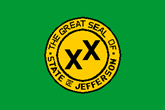
Flag of the Independent State of Jefferson 1941
- TWO-AND-A-HALF ARMED CROSS
- The term used in Eastern European heraldry – and a direct translation of the Polish
póltrzecia krzyza – that describes a Cross of Lorraine which has a third arm
projecting on one side only – usually the sinister (see also ‘cross 2)’,
‘cross of Lorraine’,
‘orthodox cross’ and
‘papal cross’).

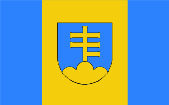
Arms and Flag of Wojaszówka, Poland
- TWO or THREE POINTED
- See ‘broad pennant’,
‘double-pointed’,
‘swallow-tail(ed)’,
‘swallowtail and tongue’,
‘triple-tailed 1)’,
‘triangular tailed’ and the note below.


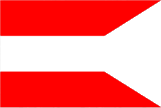
Customs Flag, Denmark);
Naval Ensign, Poland;
Flag of Zákamenné, Slovakia
Please note (as may be seen from the references given above) that flags/pennants with two or three tails/tongues have many specific variants and it is strongly suggested that the individual entries be consulted before attempting any description.
- TWO-SIDED
- 1) A term used when the reverse of a flag differs from its obverse – but see the note below (also
‘mirror image’,
‘obverse’, ‘reverse’).
- 2) See ‘double-sided 1)’.
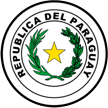
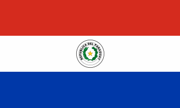

The National Flag of Paraguay
with enlarged detail of the emblems on the obverse and on the reverse (fotw
& Wikipedia)
Please note with regard to 1) that this term can include those flags where most of the
reverse is a mirror image of the obverse – for example those of Argentina, Egypt and
Brazil – but where the detail such as lettering or a charge, is made so that it can be
seen correctly on both sides.


The Globe as it should appear on both the obverse and reverse of
the National Flag of Brazil
- TYPE FLAG
- See ‘model flag’.
![[Establishment of arms example]](../images/v/vxt-d1447.gif)
Flag of Yukon Territory, Canada (Design Details Established by
Type/Model Flag)
![[Trophy flag]](../images/v/vxt-d2102.jpg)
![[trumpet banner]](../images/v/vxt-d2157.gif)
![[Schellenbaum]](../images/v/vxt-d283.gif)











![[Establishment of arms example]](../images/v/vxt-d1447.gif)

![[Trooping the Colour]](../images/v/vxt-d2077.jpg)
![[tufa]](../images/v/vxt-d3718.gif)